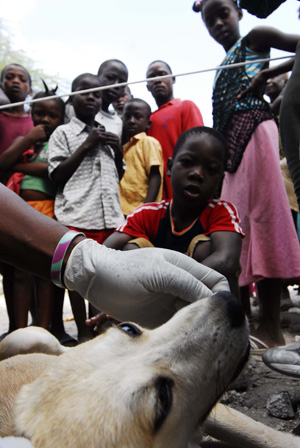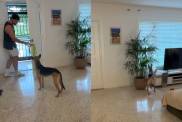By Vladimir Negron, PetMD.com.
It was not unlike any other day last January when an earthquake of enormous magnitude shook the tiny island of Haiti. If it had struck anywhere else, it would caused extraordinary damage, but the fact that it occurred in Haiti made it so much more destructive. To say that Haiti, the poorest country in the Western hemisphere, was ill prepared is an understatement. Even one year later it is still far from fully recovered.
According to official estimates, the earthquake killed nearly a quarter of a million people, injured another 300,000, and displaced 1.3 million residents in the Port-au-Prince area and in much of southern Haiti. In the wake of the disaster, humanitarian relief, that unlike ever seen before, descended upon Haiti. Even amidst some of the controversy today over slow and ineffective response, the humanitarian effort still endures. But one relief effort that does not quite gain the same publicity is the animal relief effort and its champions.
One such champion is the Animal Relief Coalition for Haiti (ARCH). Formed just days after the quake, ARCH set off to provide relief for the animal survivors and address the threat of disease spreading from animals to humans. Jointly led by the World Society for the Protection of Animals (WSPA) and the International Fund for Animal Welfare (IFAW), ARCH has far surpassed its initial goals.
“We didn’t know what sort of impact we could make early on,” said Laura Flannery, U.S. Communications Manager of WSPA. And yet, with no real animal population count or idea of how many would require medical assistance, ARCH leaders coordinated with Haiti officials and the U.N. just one day after the earthquake to direct one of the largest animal relief efforts in modern history.
“Our original goal was to treat 14,00 animals in one year,” said Kevin Degenhard, project manager for ARCH. “But, in the first two months, our team of 10 people had already treated 12,700 animals.” One year later, the ARCH coalition has helped more than 50,000 animals.
The backbone of the operation is ARCH’s mobile veterinary clinic, which allowed the team to travel into earthquake-stricken neighborhoods and provide aid and vaccinations to thousands of dogs, cats, goats, cattle, horses, and other animals. But the relief effort was not simply about treating and vaccinating animals; it also focused on assisting and training local veterinarians so that they may continue animal welfare projects long after the ARCH volunteers have left.
In one year ARCH also helped repair the National Veterinary Laboratory and main lab infrastructure, which fell during the earthquake; installed 24 solar-powered refrigeration units, which are critical to storing animal vaccinations; and launched the country’s first-ever public awareness campaign to educate Haitians about disaster preparedness, pet care, and health issues related to their pets and families.
“We’re hoping we’ve built a cornerstone, an infrastructure, for the local veterinarians and the Haitian people,” said Flannery. “Building the community is a vital part so that Haitians can continue on and have a better understanding of the importance of companion animals and livestock, and their welfare.”
It’s hard to predict what lays ahead for Haiti and its people, especially after the ARCH coalition has left, but there is little doubt that ARCH and its volunteers have equipped Haiti with the right tools to take care of its animals.
This article originally found here at PetMD.com.









